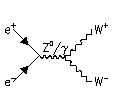
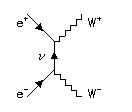
This page was nicked from OPAL.
At LEP1, the collision energy was set equal to the mass of the Z-boson,
In LEP2, the collision energy was increased to


The WWZ and WWphoton vertices in these diagrams are precisely predicted
by the Standard Model, so observations of W+W- production
can be used to test the theory.
The mass of the
Many of the events recorded are similar to those at LEP1, where a lepton
pair or quark-antiquark pair is produced in the decay of a virtual
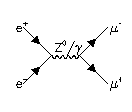
In addition, many of the events show "radiative return"; the
scattering is especially favoured if one or more photons are emitted from
the initial e+ or e-, so that the energy is reduced
to the mass of the
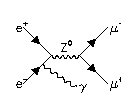
Other processes, which were comparatively rare at LEP1, become more common
at LEP2. For example, the production of a pair of photons:
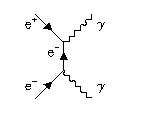
which provides a stringent test of QED, and could give indication of composite
structure of the electron.